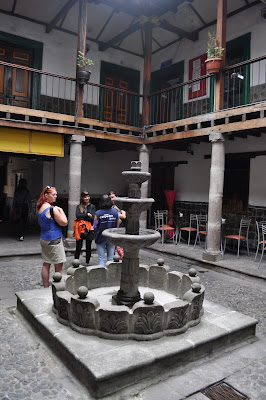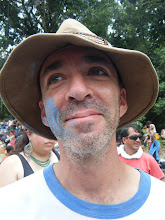Crossing the border into Ecuador from Colombia is a fairly simple process. We get a free, 90 day tourist visa. Then it is a short taxi ride to a bus station and five hours later in Quito, the cultural and historical center of Ecuador. All of this is done without ever leaving the Andes mountains. We are actually even higher than before. Quito sits at 2,850 meters (9,350 feet) and the lack of oxygen is felt. My first day I am wheezing just going up the steps of my hostel. Altitude acclimation is recommended.
 |
| View of Quito's historic center |
Quito is the capital and second largest city in Ecuador. The city was founded in 1534 by the Spanish though there is evidence of indigenous communities living here well before then. The old town of Quito was named a UNESCO world heritage site in 1978 which has done much to preserve the historic integrity of the old capital. Since then the city has extended out from the historic center. A twenty minute walk or short bus ride away is the neighborhood La Mariscal which is full of modern bars and restaurants and travelers' hostels. The area has the nickname, Gringolandia, but I think it does La Mariscal a disservice. There are a lot more well-heeled Ecuadorians here than there are foriegners. Continuing even further away from the old center are more neighborhoods, larger buildings, parks, slums and shopping malls to support the city of 1.4 million people.
 |
| A swanky cafe in the New Town |
It would be nice to say that walking through the historic area of Quito is like stepping in time, but it is really not. The colonial buildings are beautiful. Painted colorfully some peeling with age while others beautifully up kept. But in old town Quito modern life continues. The centuries old buildings and churches are a museum backdrop to a growing city. One four hundred year old building I visit houses a cafe, Spanish school and electronics store.
 |
| Old building, new stores |
 |
| Inside a 400+ year old building. I hope that the electricity is updated. |
Money:
The most noticeable thing about the money in Ecuador is that it is dollars, US dollars. In 1999 there was a major banking crisis and the Ecuadorian Sucre was so devalued that the government decided to scrap the currency and just use the US dollar as its main currency. All of the bills are US and the coins are a mix of US and Ecuadorian. There is a plethora of $1 Sacajawea coins circulating. Being from the US this is great because there are no pesky exchange rates to keep track of. When I go to the ATM to get US $100 I get US $100. The $1 bank fee actually makes it cheaper for me to get money in Quito than at the convenient store a block from my house.

Overall, traveling in Ecuador is more economical than Colombia. Backpackers say that after Bolivia (which is apparently dirt cheap) Ecuador seems to be the cheapest country on the continent. Food and lodging are just slightly less expensive here and long distance buses are about half price of Colombia. All of this adds up to some good savings for the budget conscious long-term traveler. Tourist activities seem to be pricey, but these are outside the confines of normal Ecuadorian society. Trips to the Galapagos Islands are incredibly costly, and Mika and I are still contemplating whether we should do it now or save it for another time.
Ecuadorian cuisine sticks with the general South American theme of meat and more meat then add portions of your favorite carbohydrate(rice, bread, potato). The best deal around is the Menu del Dia (Menu of the day) for lunch. For US $1.50 - $3.00+ you get soup, an entree, rice, beans and vegetable, and juice. Something in Ecuador that we did not see much of in Colombia are Chinese restaurants - called
Chifa in Ecuador. For around US $2.50 you can get a heaping plate of fried rice or noodles. The quality is not stellar, but it is at least a different taste than the same-old, same-old local food. Chinese restaurants are usually good places to find vegetarian options.
 |
| Chinese food? Noodles, french fries and cola for $2.20 |
There also is a lot of ceviche around, but I think I am going to wait until we get to the pacific coast to try an uncooked fish dish. For now we stick with
cevichochos which is sort of like a poor man's ceviche with similar taste but with two types of corn, dried plantains and pork. It is sold in small places around town and on street carts as a snack.
 |
| Cevichochos |
Safety:
While traveling in Latin American cities safety is always an issue to consider. Quito, unfortunately, seems to be the standard rather than an exception to this statement. I cannot speak statistically, but it feels much less safe here than in Bogota. First of all, there is much less of a police presence in Quito than almost anywhere in Colombia. Secondly, in Colombia we heard plenty of stories about things disappearing -- if you put your camera down it will be gone. But here in Ecuador we hear several firsthand accounts of people being physically robbed and assaulted. Of course foreigners are easy targets, but I think Ecuadorians feel less safe here compared to their Colombian neighbors. I meet two women from Buenos Aires (another large Latin American city with a bad reputation) who were shocked when a local woman convinced them to take a taxi with her only three blocks.
 |
I do not really have any photos relating to "safety" so I am inserting
random images to maintain a proper feng shui for this blog post. |
There is a common and quite annoying trick which occurs on the street. Someone sprays you from behind with something rancid, then points it out to you pretending to help clean it off. The idea is that you will remove your backpack to try to clean yourself which will quickly disappear in the hands of the sprayer's accomplice.
My second day in Quito this happens to me. I am heading back to my hostel after a day of sightseeing in Quito's old town when suddenly I feel something wet running down my leg. W.T.F? I stop to look and there is a woman behind me holding a tissue saying "ave, ave (bird, bird)." I swing my backpack around to my front with out taking it completely off to get my water. I notice the bottom corner of my backpack also has some muck on it. The smell is awful. I douse my pants and backpack with water while the lady tells me there is more on my back. I tell her that I will clean it off at my hotel and quickly walk off. Only one block away does my brain process what just occurred.

I have heard that these thieves use mustard. The common hot dog condiment would have been much more preferable to the used baby diaper bi-product that I am sprayed with. It is disgusting. I am fuming as I am scrubbing my clothes in the shower and feel like an ass that I would be targeted for the scam. However, after talking with other travelers I find out it is not all that uncommon. It just happened to one couple two days before me, while another woman from New Zealand said that this happened to her three times in Buenos Aires! That makes me feel better.

Now I do not want to be a fear monger and steer people away from visiting Quito. Thousands come and go without incident. But it is a shame that people always have to stay alert. When leaving the hotel I have to really consider if it is worth it to carry my expensive camera. If I do, my backpack stays on my front so I look like a dork (well, a bigger one than usual) and now I look behind me all the time when walking on the street.
The next post will be about Things to do in Quito. Stay tuned...







































































